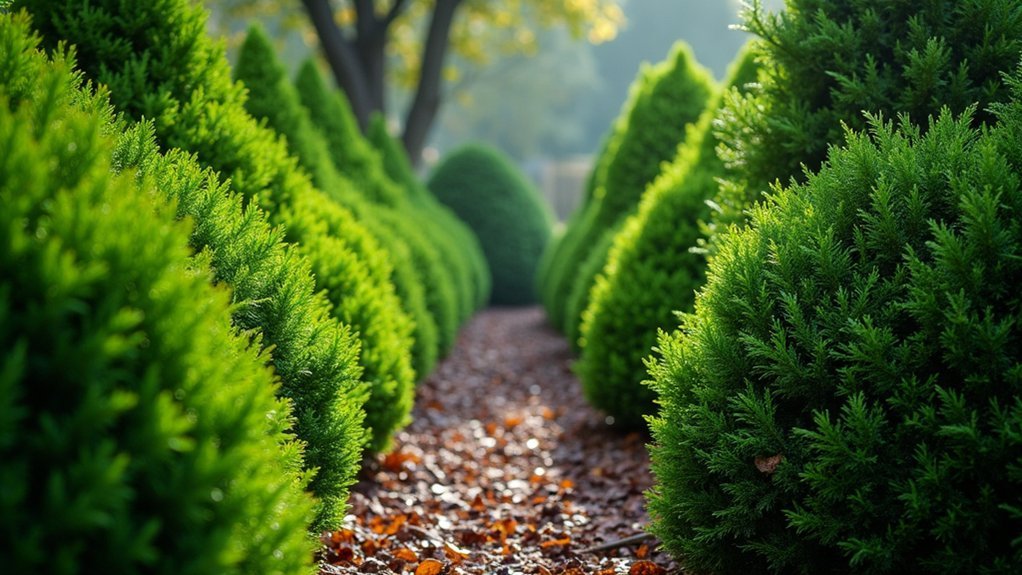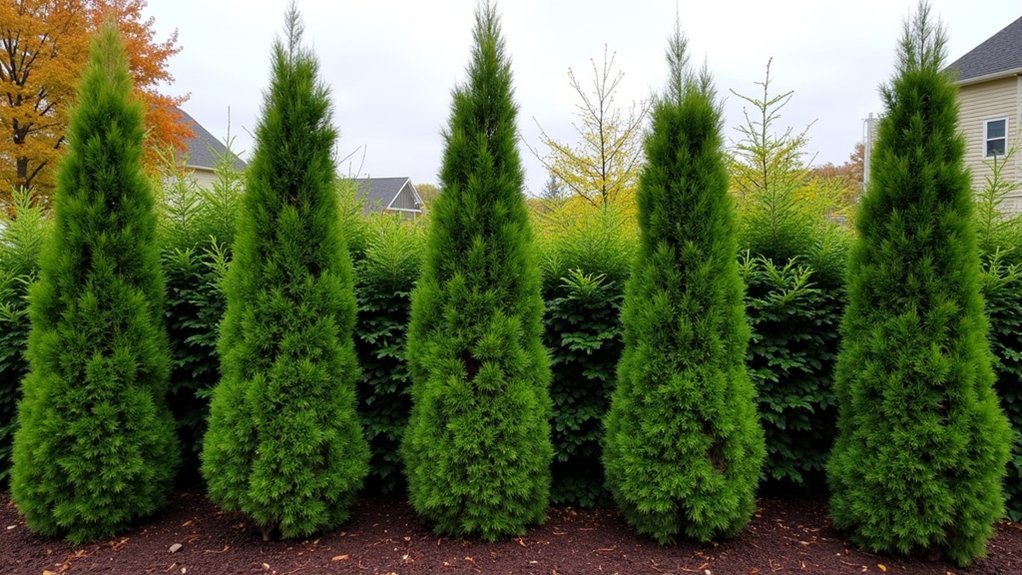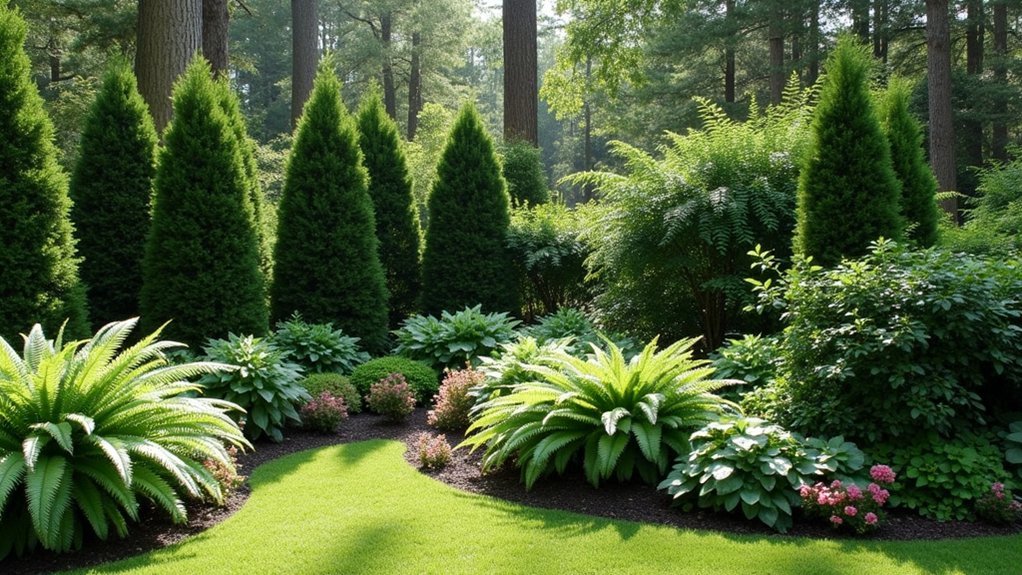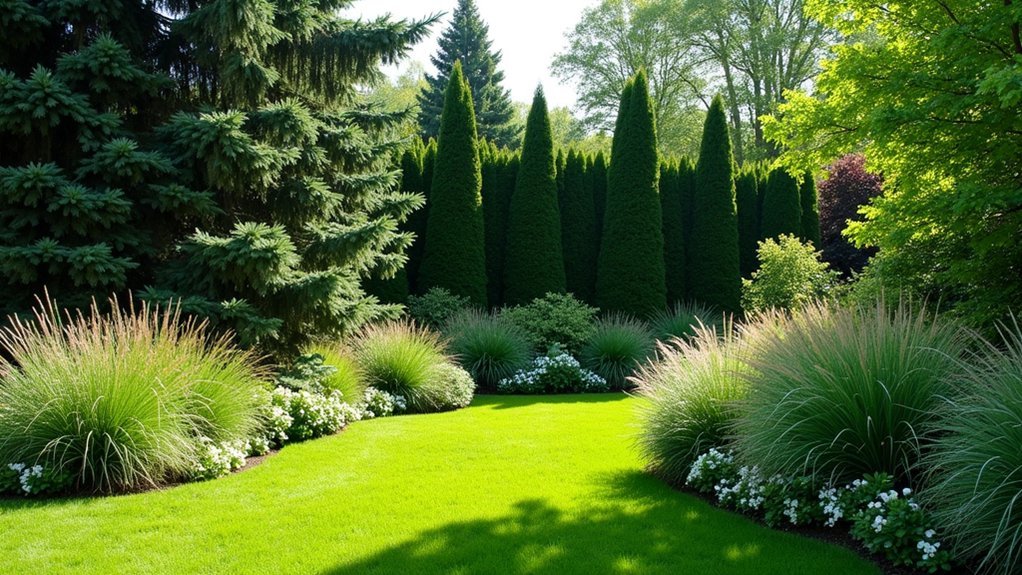Privacy plants for northern exposures offer unique advantages. You’ll find that shade-tolerant varieties like Cherry Laurel and Arborvitae thrive in these cooler, moisture-rich conditions while creating effective screening. These natural boundaries soften architectural lines, improve energy efficiency, and support wildlife. By combining evergreens for structure with deciduous shrubs like Forsythia and Beautyberry, you’ll enjoy year-round interest with less maintenance than sun-loving alternatives. Your challenging north-facing space can become your garden’s most distinctive feature.
Understanding Northern Exposure Conditions for Privacy Plants

Shade creates both challenges and opportunities when planning a privacy screen for northern-facing areas.
When you’re working with northern exposure, you’re dealing with considerably less direct sunlight throughout the day. This means your plants will primarily receive indirect light, creating part shade to full shade conditions depending on surrounding structures and trees.
The good news is that many shade-tolerant privacy shrubs actually thrive in these cooler, moister environments.
Northern exposures typically maintain higher soil moisture levels and provide protection from harsh afternoon sun, which can benefit certain varieties.
For zone 6 gardens in southwest Missouri, this environment can be particularly advantageous when paired with clay soils that retain moisture well.
Understanding these specific conditions helps you select privacy plants that won’t just survive but will flourish in your northern-facing landscape.
Benefits of Natural Privacy Boundaries in Low-Light Areas
While many homeowners view northern exposures as challenging spaces, these low-light areas actually offer ideal conditions for creating natural privacy boundaries that serve multiple purposes beyond simple screening.
Privacy plants in northern exposure settings soften harsh architectural lines, transforming stark exteriors into inviting, naturalistic spaces. Fast-growing varieties like Cherry Laurel and Japanese Holly quickly establish visual barriers in partial shade, providing immediate seclusion where you need it most.
You’ll also enjoy improved energy efficiency as these plantings create insulation and reduce wind exposure around your home.
Beyond aesthetics and comfort, natural privacy boundaries in low-light areas contribute to local biodiversity, creating wildlife habitats even in urban environments.
Top Evergreen Shrubs That Thrive in Northern Shade

Rhododendrons offer stunning seasonal blooms while creating dense, colorful privacy barriers that can transform your northern landscape even in low light conditions.
You’ll find yews particularly valuable for deeply shaded northern exposures, where their rich green needles form impenetrable living walls regardless of minimal sunlight.
Holly varieties provide both security and visual interest with their distinctive glossy foliage and bright berries, ensuring your privacy screen remains effective and attractive throughout all seasons.
Rhododendrons Create Colorful Barriers
Creating private, shaded spaces in northern exposures becomes remarkably easier with rhododendrons. These versatile evergreens offer superior plant information for homeowners seeking year-round privacy solutions. They thrive where other shrubs struggle, maintaining their lush foliage even during winter months.
Pro vs. con considerations heavily favor rhododendrons for northern barriers. They reach impressive heights of 3-10 feet while tolerating partial to full shade conditions.
You’ll appreciate their moderate growth rate of 1-2 feet annually, providing substantial coverage without demanding excessive maintenance.
Your northern landscape will benefit from rhododendrons’ preference for acidic, well-drained soil—a common condition in many northern regions.
When spring arrives, you’ll enjoy the bonus of vibrant blooms that transform your privacy screen into a stunning seasonal display.
Yews Tolerate Dense Shade
When sunlight becomes scarce in northern exposures, yews stand as exceptional privacy solutions. These adaptable evergreens thrive in conditions where many plants struggle, making them perfect for your shadiest garden spots.
You’ll appreciate how yews handle difficult clay soils common in northern regions without complaint. Growing at a manageable pace of 6-12 inches yearly, they’ll develop into substantial privacy screens without overtaking your space.
Depending on the variety you choose, you can find yews that mature between 2-20 feet tall, giving you flexibility for different screening needs.
What’s particularly appealing is their low-maintenance nature. You won’t need to fuss with constant pruning as yews naturally maintain their dense, bushy form.
Their resilient growth habits guarantee you’ll enjoy lasting privacy even in challenging northern conditions.
Holly Provides Year-Round Privacy
While many privacy plants struggle in northern shade, holly stands out as a remarkable exception that delivers year-round screening with distinctive character.
Thriving in zones 3-10, holly adapts beautifully to the reduced light conditions of northern exposures, offering dense foliage that effectively blocks unwanted views.
You’ll appreciate holly’s versatility with its growth habits ranging from upright pyramidal to mounding forms, reaching anywhere from 1-1/2 to 80 feet depending on variety.
This gives you options for any privacy need, whether you’re seeking a low border or tall screen.
- Provides ornamental winter berries when most gardens lack visual interest
- Offers growth rates from slow to fast, letting you choose based on your maintenance preferences
- Creates effective year-round screening with its exceptionally dense evergreen foliage
Deciduous Options for Seasonal Privacy Screens

While deciduous shrubs like Forsythia and Beautyberry shed their leaves in winter, they’ll transform your northern exposure garden into a leafy sanctuary during summer months.
You’ll enjoy not only privacy but also seasonal drama as Forsythia’s bright yellow spring flowers and Beautyberry’s purple fall fruits create visual interest throughout the growing season.
The bare branches of these privacy plants offer striking structural elements during winter, adding architectural appeal to your landscape even when dormant.
Leafy Summer Sanctuaries
Although they shed their leaves in winter, deciduous shrubs offer unmatched seasonal privacy during warmer months when you’re most likely to enjoy your outdoor space.
Varieties like Forsythia and Hydrangea create lush, vibrant barriers that transform northern exposures into secluded retreats without overwhelming your landscape.
These medium to fast-growing plants achieve practical heights of 3-10 feet, perfect for screening while still allowing winter sunlight to penetrate your garden when foliage disappears.
Consider these deciduous standouts for your northern exposure:
- Mock Orange – Provides fragrant blooms and dense summer foliage
- Beautyberry – Offers spectacular fall berries that attract wildlife
- Hydrangea – Features dramatic blooms and substantial screening potential
You’ll appreciate how these seasonal performers create dynamic, changing landscapes throughout the year while maximizing available northern light during each season.
Winter Structural Interest
Even after leaves fall, deciduous shrubs can offer surprising winter appeal in your northern exposure garden. Forsythia and Beautyberry transform through the seasons while maintaining visual interest year-round.
In winter, their bare branches create artistic silhouettes that allow precious light to filter through—a significant advantage for northern exposures.
Beautyberry delivers spectacular purple berries that persist after leaf drop, providing structure and color during the coldest months.
Forsythia compensates for its winter simplicity with a breathtaking yellow bloom explosion in early spring, heralding the new growing season.
When selecting deciduous privacy options for northern sites, consider their growth patterns and maintenance needs.
You’ll enjoy a dynamic privacy screen that shifts with the seasons while maintaining architectural presence even in winter’s stark landscape.
Growth Rates and Establishment Timelines for Shade Plantings
When planning your northern exposure privacy screen, understanding growth rates becomes essential for setting realistic expectations. Shade-tolerant shrubs like Cherry Laurel and Japanese Holly can grow 1-3 feet annually, providing relatively quick coverage despite lower light conditions.
Meanwhile, medium-paced options such as Euonymus and Forsythia offer a balanced approach with 1-2 feet of yearly growth in partial shade.
For best results with your northern exposure privacy plantings:
- Choose faster-growing species like Cherry Laurel if you need a visual barrier established quickly.
- Consider slower varieties like Boxwood if you’re planning for long-term landscaping with minimal maintenance.
- Assess your specific light conditions carefully, as even shade-tolerant plants have varying requirements that affect their establishment timeline.
Creating Multi-Layered Privacy Barriers in Limited Sunlight

You’ll create more effective privacy screens in northern exposures by strategically layering shade-tolerant plants like Japanese Holly and Beautyberry from back to front.
Combining evergreens with deciduous shrubs guarantees your privacy barrier maintains its functionality throughout all seasons while adding textural interest.
Vary your foliage selections by incorporating different leaf shapes, sizes, and colors to transform a simple privacy screen into a visually dynamic landscape feature even in limited sunlight.
Layering Shade-Tolerant Species
Creating a multi-layered privacy barrier in northern exposure requires thoughtful planning since limited sunlight presents unique challenges.
You’ll need to select plants like Japanese Holly and Boxwood that naturally thrive in low-light environments while providing effective screening.
For maximum effectiveness, combine evergreen and deciduous varieties such as Arborvitae and Forsythia to guarantee year-round privacy with seasonal interest.
When positioning your plants, remember:
- Space according to mature size to prevent overcrowding and competition for limited sunlight
- Place taller specimens at the back, with smaller shrubs like Beautyberry in front to create visual depth
- Establish a regular pruning schedule to maintain desired heights and ensure each layer remains healthy
This strategic layering approach maximizes available light while creating an attractive, functional privacy screen.
Texture Through Foliage Variety
Though limited sunlight poses challenges, a northern exposure garden can still boast a visually striking privacy screen through thoughtful foliage combinations.
You’ll create depth by pairing the vibrant berries of Beautyberry with the consistent structure of Arborvitae, ensuring year-round interest while maintaining privacy.
Mix Chinese Fringe Flower and Holly to introduce varied foliage colors and shapes that thrive in partial shade.
This combination delivers visual texture while serving as an effective screen.
Balance slow-growing Boxwood with faster-developing Cherry Laurel for immediate privacy that won’t become overwhelming as plants mature.
For dimensional layering, incorporate Forsythia’s tall, arching branches alongside low-growing Euonymus.
This strategic height variation maximizes limited planting areas while creating a rich tapestry of textures that transform your northern exposure into a private, dynamic sanctuary.
Maintenance Considerations for Northern Exposure Hedges
Maintaining privacy hedges in northern exposures requires special attention to the unique challenges of limited sunlight conditions. Your slow-growing varieties like Boxwood and Japanese Holly will need less frequent pruning, making them lower-maintenance options compared to fast-growing Cherry Laurel.
When caring for northern exposure privacy plants, focus on:
- Regular monitoring of available sunlight – northern exposures receive primarily indirect light that affects growth rates.
- Soil assessment and amendment – clayish soils common in northern areas may need improvement for ideal plant health.
- Height management – consider the mature size of species like Forsythia and Hydrangea, which can quickly outgrow their space.
Native Privacy Plants Adapted to Northern Conditions

When selecting the right privacy plants for your northern garden, native species offer compelling advantages beyond just ease of maintenance. American Holly and Eastern Red Cedar thrive in cooler climates, providing year-round privacy while naturally adapting to local soil conditions.
| Plant Species | Benefits | Seasonal Interest |
|---|---|---|
| American Holly | Dense evergreen coverage | Bright red berries in winter |
| Eastern Red Cedar | Drought-tolerant barrier | Blue-gray foliage year-round |
| Witch Hazel | Wildlife-friendly screen | Fragrant winter blooms |
You’ll find these native privacy options require less water and fertilizer than exotic alternatives. They’re also more resistant to regional pests and diseases, eliminating the need for chemical treatments. By choosing native plants, you’re creating both a beautiful privacy screen and supporting local birds, pollinators, and ecological balance in your northern garden.
Combining Aesthetics and Functionality in Shade Borders
Artful privacy barriers transform northern exposure areas into inviting retreats while solving the challenge of limited sunlight. By selecting shade-tolerant varieties like Japanese Holly and Cherry Laurel, you’ll create year-round screening that thrives even in limited light conditions.
Transform your shadiest spaces into secluded sanctuaries with carefully chosen plants that embrace, rather than fight, low-light conditions.
Your shade border becomes more dynamic when you mix evergreen and deciduous shrubs, offering privacy with seasonal interest as foliage and blooms change throughout the year.
For maximum impact in your northern exposure garden:
- Group plants strategically to maintain proper air circulation, preventing common shade-related diseases.
- Use privacy plantings to define distinct areas for relaxation or entertainment.
- Space plants appropriately to create visual cohesion while ensuring each specimen has room to develop its natural form.
These approaches work especially well in compact urban settings where defined garden spaces are highly valued.
Soil Requirements for Successful Shade Boundary Plants
Three vital soil factors determine whether your northern exposure privacy plants will merely survive or truly thrive.
First, drainage is paramount—shaded areas retain moisture longer, potentially causing root rot. Ascertain your soil drains well while still holding adequate moisture by incorporating organic matter.
If you’re dealing with clayish soil, common in northern areas, add compost to improve aeration and structure while providing nutrients.
Your soil’s pH should ideally fall between 6.0 and 7.0, as most shade-tolerant varieties prefer slightly acidic to neutral conditions.
Don’t overlook mulching—it regulates soil temperature, retains moisture, and suppresses weeds.
Regular moisture monitoring is also vital in these shadier spots.
With these soil fundamentals addressed, you’ll create an environment where your privacy plants can flourish.
Space-Saving Vertical Privacy Solutions for North-Facing Areas
Limited space needn’t compromise your privacy aspirations in north-facing areas. Vertical-growing shrubs like Arborvitae excel in tight spaces, reaching impressive heights while maintaining slim profiles perfect for narrow planting strips. You’ll get maximum screening with minimal footprint.
For north-facing constraints, consider these space-efficient options:
- Japanese Holly – Thrives in shade and creates dense visual barriers without sprawling width.
- Boxwood – Maintains compact form while providing year-round screening in limited sunlight.
- Cherry Laurel – Grows quickly (1-3 feet annually) and adapts well to cooler, shaded conditions.
Remember to plan your spacing carefully—even slender varieties need adequate room to reach maturity.
Combining evergreen and deciduous selections creates dynamic, year-round privacy with seasonal interest while maximizing your limited north-facing space.
Year-Round Visual Interest With Northern Privacy Plantings
Creating privacy in north-facing areas isn’t just about filling space—it’s about crafting a view you’ll enjoy throughout all seasons.
Privacy screens in north-facing spaces should double as living art, offering year-round visual interest beyond mere function.
You’ll want to incorporate evergreens like Arborvitae and Holly, which maintain their lush foliage even during winter months in zones 2-10.
For dynamic seasonal changes, add deciduous shrubs such as Forsythia and Hydrangea. These provide vibrant blooms in warmer months while creating interesting branch patterns when dormant.
Chinese Fringe Flower and Beautyberry offer unique flowers and colorful berries that maintain visual appeal despite reduced sunlight.
Consider mature sizes when selecting plants—Boxwood and Cherry Laurel deliver dense screening while fitting into limited spaces.
Create a layered landscape by combining various heights, colors, and textures to guarantee your north-facing privacy screen remains visually enchanting year-round.
Frequently Asked Questions
Is Northern Exposure Good for Plants?
Northern exposure can be good for your plants, especially shade-loving varieties. You’ll find many species thrive in this indirect but bright light, as it prevents sunburn and heat stress on sensitive foliage.
What Is the Best Plant for a North Facing Wall?
For a north-facing wall, you’ll find Japanese Holly and Boxwood are excellent choices. They’re shade-tolerant and thrive in indirect light. Cherry Laurel works well too if you’re looking for rapid height development.
Why Are North Facing Windows Bad for Plants?
North facing windows are bad for plants because they don’t provide enough sunlight. You’ll notice your plants receiving less than six hours of direct light daily, which hampers growth, causes leggy stems, and slows flowering.
What Grows Best on the North Side of a House?
For the north side of your house, you’ll find that shade-tolerant plants thrive best. Consider hostas, evergreen shrubs like arborvitae, and adaptable deciduous options such as beautyberry and forsythia for year-round interest.
In Summary
You’ve seen how northern exposure privacy plants offer practical beauty despite limited light. They’ll create a natural barrier while bringing life to shadier spots of your garden. By selecting the right mix of evergreens and deciduous varieties, you’ll enjoy privacy year-round with minimal maintenance. Choose plants suited to your specific conditions, and you’ll transform that challenging northern boundary into your garden’s most attractive feature.





Leave a Reply